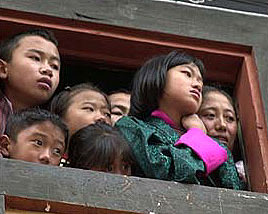|
Bhutan:
Women, Children & Gender
|
 |
 |
| Bhutanese
women constitute 49.5 percent of the country's total population and play
a major role in the development of the country. They are actively involved
in all areas of economic, political and social life as farmers, entrepreneurs,
decision-makers, doctors, engineers and homemakers. Bhutanese women do
not face any institutionalized form of discrimination- politically, socially,
economically or legally. Law treats women and men equally and many of its
provisions protect the rights and interests of women and children. |
|
The
participation of women and men equally and many of it's of women in decision-making
such as at community meetings at the grass roots level is high as 70 percent.
Participation of women in district and block development council is also
being actively promoted and is increasing. Positions in the higher levels
of government and decision-making, in which women are not yet adequately
represented, are open to both genders and placement of women in the higher
strata of government is being encouraged.
| In
the field of education the enrolment of girls in the primary level at 46
percent in 2000 is one of the highest in the SAARC region as well as in
the developing countries. Maternal and child health too has been accorded
high priority by the government. Effective service delivery and aggressive
advocacy campaign in areas of safe motherhood, concept of small family,
women empowerment, adolescent reproductive health and prevention of STD/HIV
diseases have also attributed to the general improvement of health of women
and children. |
 |
There
is no significant preference for the male child over the female among most
sections of the population and sex-biased abortions are unknown among the
Bhutanese. In traditional society, most of which is matriarchal, women
were expected to hold the house and landed property while sons would leave
home and settle in their wives' house. This custom is based on the believe
that women need economic security to enable them to take care of their
parents and raise children. This has led to the customary rights of importance
by daughters. It is estimated that almost half of land-registered titles,
which is an index of property distribution, are recorded in favor of women.
According to a gender pilot study conducted in 2001, in rural areas, 60
percent of the landowners are women and in urban areas, building and business
licenses was registered in favor of women.
 |
| The
concept of the 'head of households' is a relative one. Household decision-making
varies from one issue to another and on the capacity of the individual.
There is no fixed appointment of roles to either the wife or the husband.
In a case of divorce, laws provide fair share for equitable spousal and
child support. |
|
The
National Women's Association of Bhutan (NWAB) was established in 1981 to
enhance the role of women at all levels of the development process. The
association with nationwide chapters has successfully addressed the various
needs of rural women through a variety of program like education, family
healthcare, skills training, employment and rural credit facilities.
 Labor Labor |
The
Labor in Bhutan and their working conditions are guided by the national
wage rate. The Government from time to time closely monitors it. The Government
also reviews and recommends labor wage rates to the National Assembly. There
is a provision for all people above 17 and below 65 years of age to be
employed under the existing regulations. The National Assembly has also
laid down terms and conditions concerning the labor recruiting agencies
that must conform to the regulations ? The Chathrim for National Workforce
(1994). |
 |
| There
is no discrimination on the basis of gender and thus, both men and women
including manual workers draw same wages with free and equal opportunities
and facilities for employment as provided in the employment regulations. |
|






